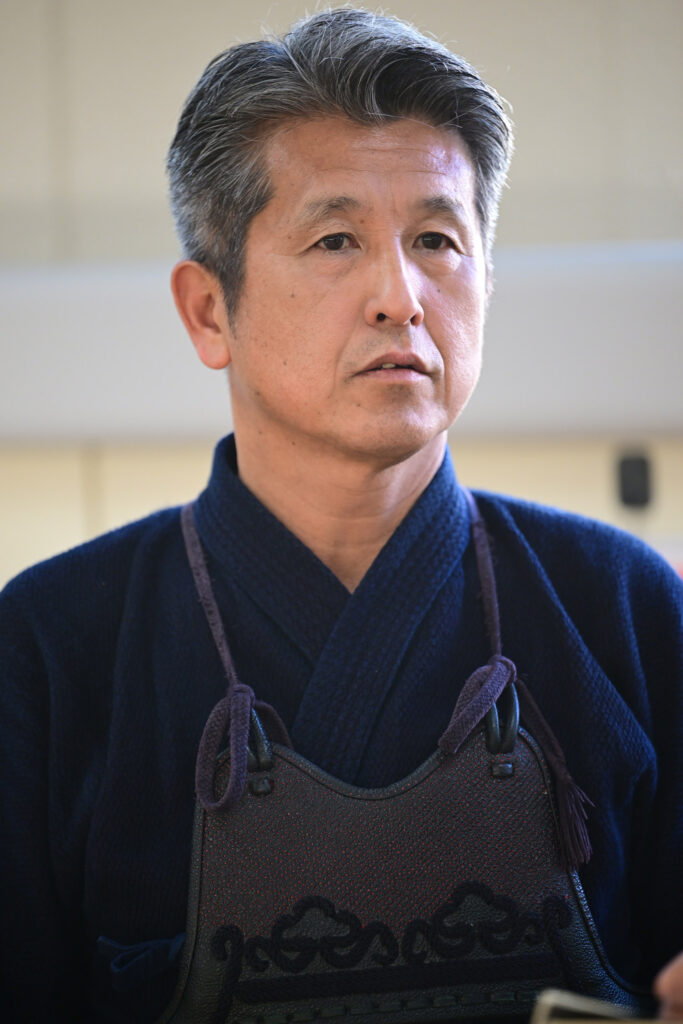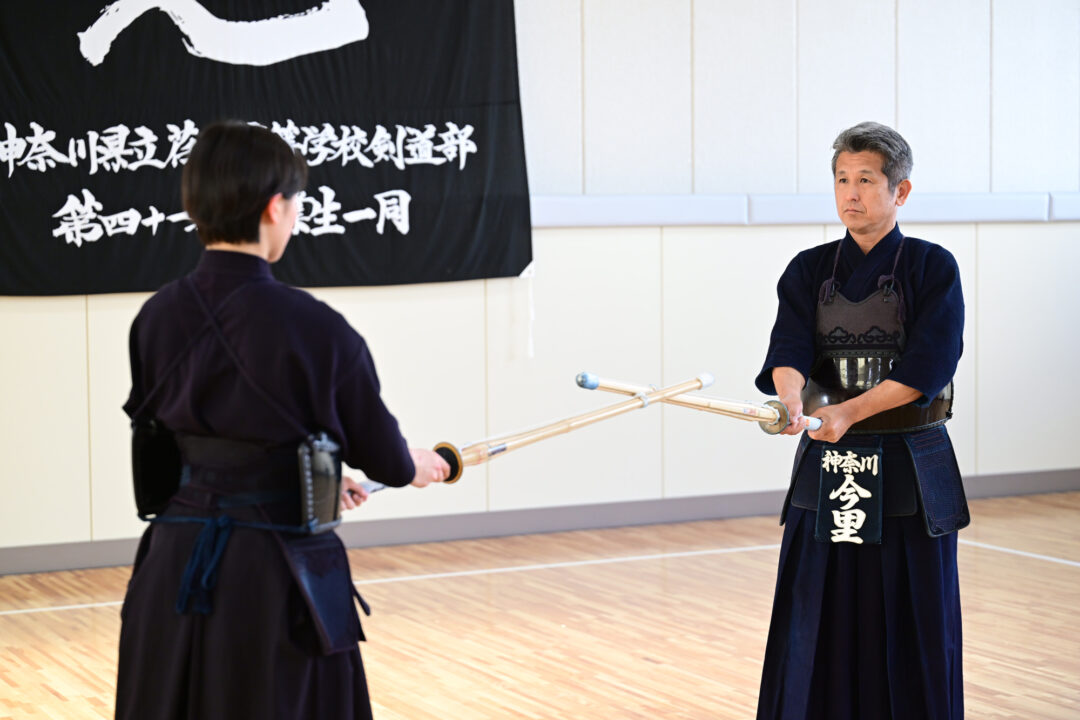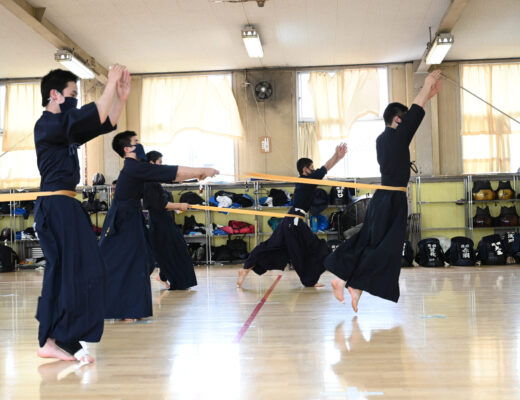2024.7 KENDOJIDAI
Composition: Tsuchiya Tomohiro
Photography: Nishiguchi Kunihide
Translation: Pepijn Boomgaard
In order to break down your opponent through Seme, it is necessary to use skillful Ken-sabaki (sword movement) and Ashi-sabaki to pressure Omote and Ura, and up and down. How do you use precise Seme and connect it to techniques that lead to Ippon? Imazato Manabu, a public high school teacher in Kanagawa Prefecture who has led many schools to participate in national tournaments, explains Omote and Ura Seme, and how to use the Shinogi on both sides.
Imazato Manabu (Kyoshi 8th Dan)

Born in Kanagawa Prefecture in 1964. Graduated from Tokai University Sagami High School and Tsukuba University. After graduation, he became a teacher in Kanagawa Prefecture. He has participated in tournaments such as the National Sports Festival (Kokutai), the All Japan Interprefecture Tournament, the All Japan Teachers’ Tournament, the All Japan Tozai Taiko Tournament, and the All Japan Invitational 8th Dan Championship. Currently, he is a teacher at Eda High School, vice director of the All Japan High School Athletic Federation’s Kendo Division, director of the Kanagawa Kendo Federation, and head instructor of Tsuoka Kenyukai.
Pressure the opponent in three dimensions
Regarding today’s theme of pressuring Omote and Ura, I would like to start with the basics. One thing I apply and also teach my students is to pressure the opponent three-dimensionally. In Kendo, it is often said that the conversation between the two Kensen is important. I understand this to mean to predict and anticipate the opponent’s movements throughout the changes induced by taking Omote and Ura , or pressuring their fists from above or below. In other words, it is important to induce changes in the opponent by pressuring them in three dimensions.
At the level of the All Japan Kendo Invitation 8th Dan Championship, which I recently participated in, it is not always possible to follow this theory, but here is what I tell my high school students.
First of all, Shikake-waza. There are four major types of people: those who hold the Shinai softly, those who hold it tightly, those with a high Kensen, and those with a low Kensen. Dividing these into patterns, high techniques are effective against those who hold their Shinai softly and have a low Kensen. You can push and hit their Kensen from above, and strike Men or Tsuki before their Shinai returns. On the other hand, against those with a high Kensen, you can use Harai from the Ura side and strike Kote or Men. Maki-waza should also be effective.
Conversely, if their grip is tight, their Shinai will rebound even if you push it down. You have to make use of this. In other words, if their Kensen is low, take Ura and strike Tsuki or Men when they don’t like it. Alternatively, take Omote and and as their Shinai comes back, strike Men or Tsuki from Ura. On the other hand, if their Kensen is high, pressure their Shinai from Omote slightly and show them the intention of striking Men. The opponent will rebound and move their Shinai back, providing an opportunity for Kote, or Men or Tsuki from Ura.
It is important to note that if your opponent is aiming for Debana, you might create an opportunity to strike for your opponent the moment you press down their Kensen, so they might attack. In this situation, it is not a good idea to do something to their Kensen before striking.
If you are facing someone who is quick to seize Debana, and you try to constrain them by moving between Omote and Ura, they will take advantage of it. Therefore, it is important to read your opponent’s citation and intentions during the Seme process. You should think of your Shinai as an extension of your hands and probe your opponent.
Ashi-sabaki is also important. If you first press the opponent’s Kendo down and then strike, you will be too slow, and your opponent will avoid or take over your attack. When you press, you must pull in your left foot and be ready to strike instantly.
Using the Shinogi in Oji-waza
Following Shikake-waza, let’s look at Debana and Oji-waza. In Kendo, the right hand is placed in front, so the Ura side, which is where the left Shinogi is, is stronger. When you press down Omote and Ura from above, it becomes obvious that the Omote side is stronger. Therefore, the basic techniques are performed from Omote. Most people are also used to using the left Shinogi to receive strikes. Debana-men is performed as if riding on top of the opponent’s Kensen and striking after momentarily taking the center. On the other hand, if you pressure Ura, it is easier to strike Kote. However, you need to be aware that it will be just as easy for the opponent to strike. Depending on the trajectory of the opponent’s Men, it might sometimes be effective to strike Men from the Ura side. This can only be used if your Seme is effective in avoiding the risk of being struck Kote.
As for Oji-waza, techniques using the Omoto Shinogi are Suriage-men and Kaeshi-do. I often choose Kaeshi-do when facing someone who strikes firmly. On the other hand, when facing an opponent who does not cut through or stops their body, or someone who is wary of Kaeshi-do and lowers their hands, techniques such as Suriage-men will be useful.
The most common techniques to employ the Ura Shinogi and Ura Taisabaki (body movement) are Kote-suriage-men and Nuki-waza. In the Nihon Kendo Kata, the 2nd, 4th, 6th, and the 2nd Kodachi Kata also contain techniques that use Tai-sabaki towards Ura. One of the characteristics of the Nihon Kendo Kata is that many of the techniques emphasize Tai-sabaki towards the Ura side. We can reference the use of the Ura Shinogi and Ura Tai-sabaki and emply them to techniques in Shinai Kendo.
When your opponent performs Ura techniques or Surirage, you will feel as if your techniques have completely disappeared. As your left foot and hand are in front, moving to the left will make it difficult to move on to the next technique. On the other hand, If your strike is received on the Omote side, you should feel as if your technique is firmly blocked.
Using the Shinogi requires Tenouchi
The rest of this article is only available for Kendo Jidai International subscribers!



